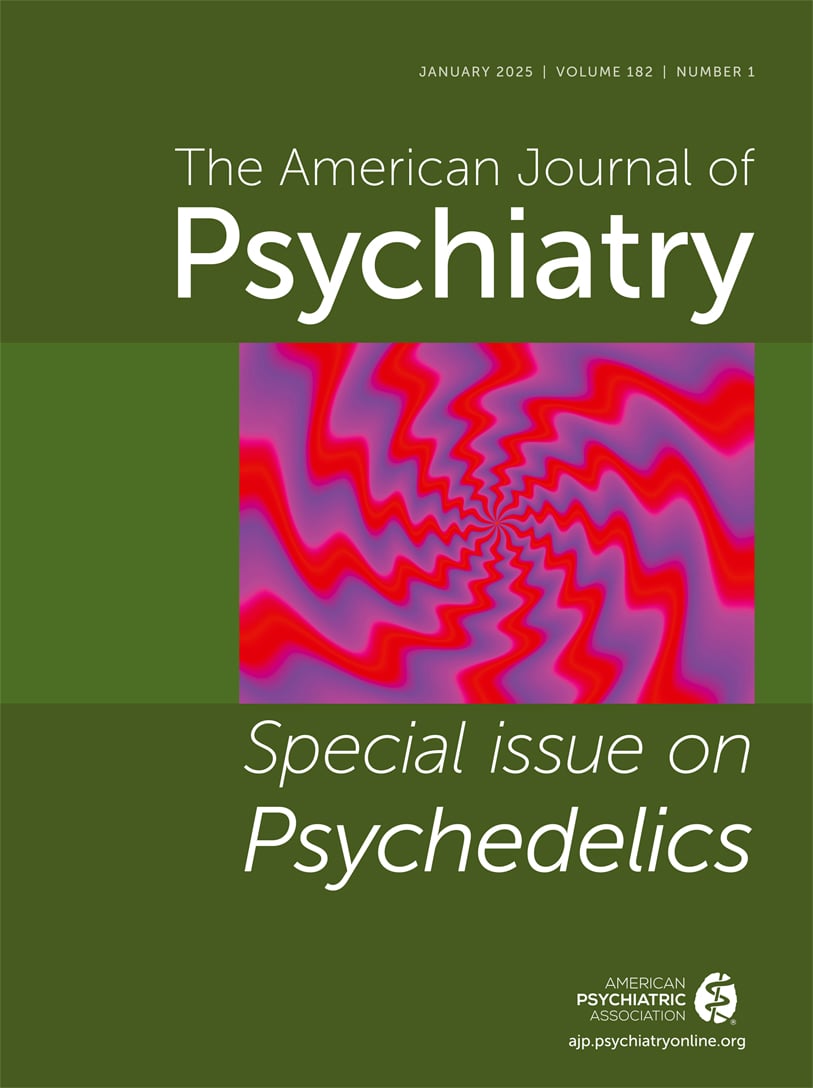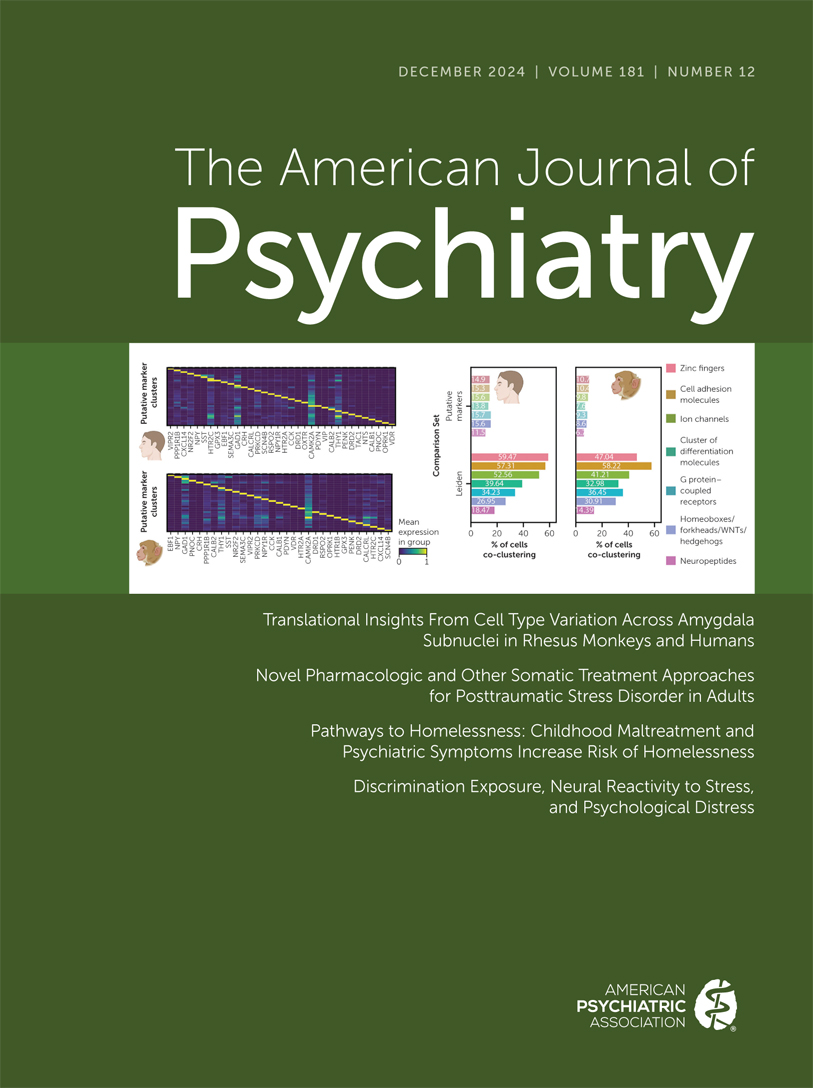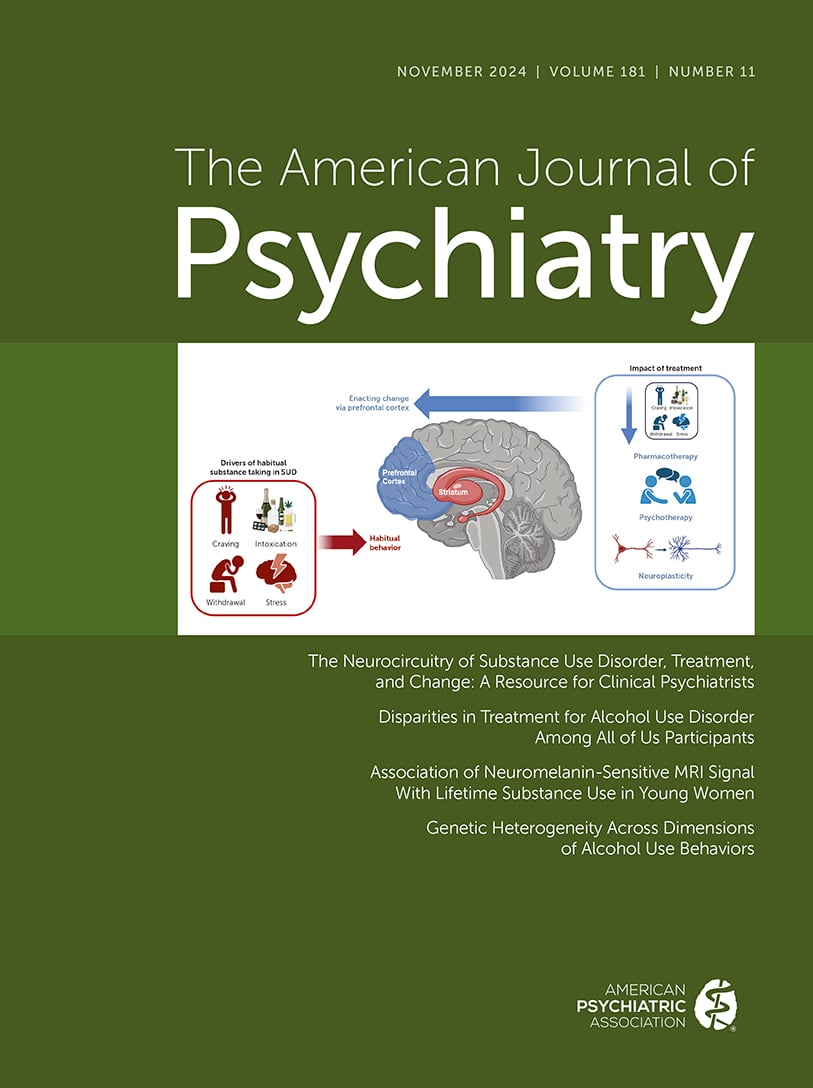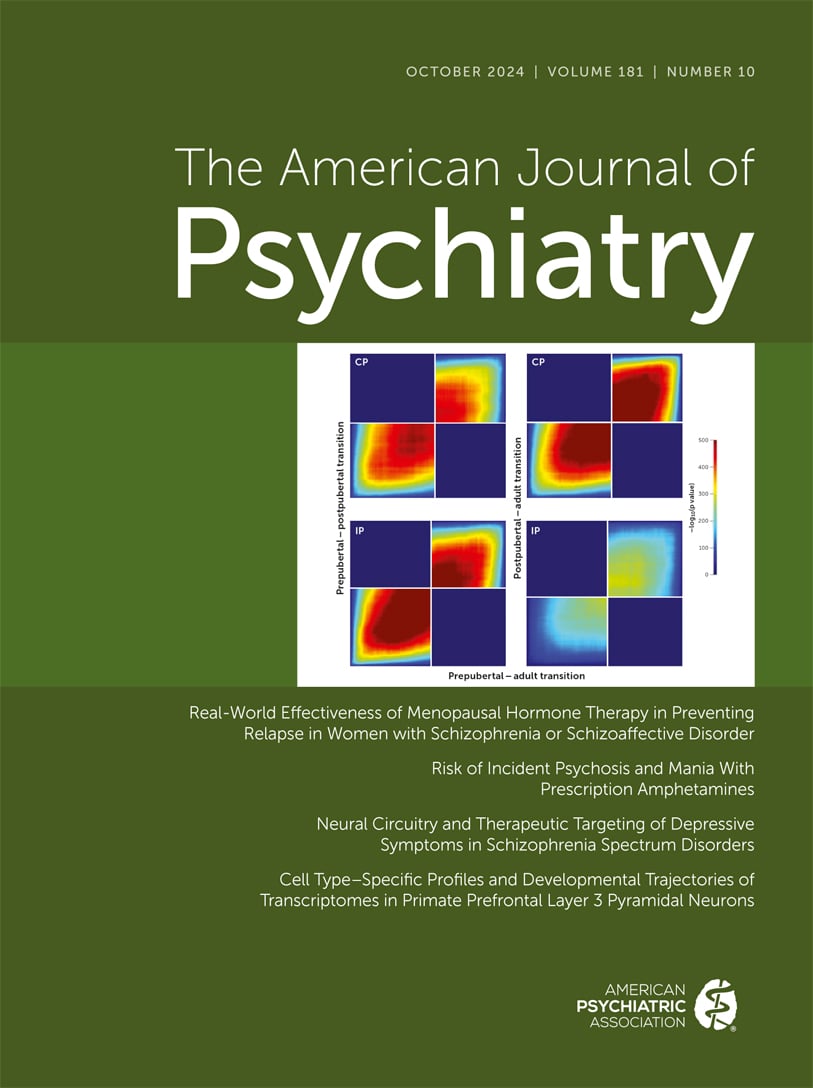American Journal of Psychiatry
- Volume 136
- Number 4B
- April 1979
ARTICLES
Publication date: 01 April 1979
Pages502–507The author presents data on the relationships between life events, coping resources, and depressive symptomatology. A probability sample (N =517) was interviewed three years apart. Respondents with high life-event scores had significantly more depressive ...
https://doi.org/10.1176/ajp.1979.136.4b.502Publication date: 01 April 1979
Pages508–511The authors assessed the occurrence of stressful life events before the initial or subsequent episodes of affective illness in a group of 79 bipolar I manicdepressive patients who were attending a lithium clinic. About half of the patients recalled a life ...
https://doi.org/10.1176/ajp.1979.136.4b.508Publication date: 01 April 1979
Pages511–515The author discusses the impact of parental disability, particularly parental depression, on children. Depression in children, which takes differentforms according to the child’s developmental level, may mirror or be a response to similar affect in a ...
https://doi.org/10.1176/ajp.1979.136.4b.511Publication date: 01 April 1979
Pages516–520The author hypothesizes that certan types of persons at high risk for suicide constitute definable clinical models, that the process of arriving at a suicidal outcome involves elements unique to each model, and that these elements can be considered ...
https://doi.org/10.1176/ajp.1979.136.4b.516Publication date: 01 April 1979
Pages521–523The authors report four cases of depression manifesting as organic brain syndrome in adult nongeriatric patients. The correct diagnoses in three cases were made by a psychiatrist’s or resident’s empathic response to the patient, and in the fourth by the ...
https://doi.org/10.1176/ajp.1979.136.4b.521Publication date: 01 April 1979
Pages524–526The authors compared levels of depression among 24 wives of nuclear submarine personnel under conditions of husband-presence and husband-absence in a crossover research design. The wives had significantly higher depression scores under conditions of ...
https://doi.org/10.1176/ajp.1979.136.4b.524Publication date: 01 April 1979
Pages526–529In order to investigate the long-term psychological consequences of Viet Nam combat, the authors located and personally interviewed a group of 571 randomly selected Viet Nam veterans and 284 matched civilian controls 3 years after the veterans returned to ...
https://doi.org/10.1176/ajp.1979.136.4b.526Publication date: 01 April 1979
Pages530–534The authors describe the results of a matched case-control analysis in which 82 pairs of subjects were selected from a large-scale community study carried out in two general populations. Cases were those of persons hospitalized during an interval between ...
https://doi.org/10.1176/ajp.1979.136.4b.530Publication date: 01 April 1979
Pages535–539The authors studied monoamine metabolism in patients with bipolar (manic-depressive) and unipolar depressive illness and in normal control subjects under strict dietary conditions before and during administration of carbidopa, a peripheral decarboxylase ...
https://doi.org/10.1176/ajp.1979.136.4b.535Publication date: 01 April 1979
Pages540–542Intense exercise for one hour induced a significant increase in plasma cyclic adenosine monophosphate (cAMP) in 5 healthy volunteers. In 44 manic-depressive patients, cAMP levels correlated more strongly with mood ratings than with activity scores. The ...
https://doi.org/10.1176/ajp.1979.136.4b.540Publication date: 01 April 1979
Pages543–547Of 54 male psychiatric patients undergoing dexamethasone suppression tests in a clinical setting, 40% of those with a major depressive disorder showed escape from suppression over the 24 hours after dexamethasone administration, while all of the patients ...
https://doi.org/10.1176/ajp.1979.136.4b.543Publication date: 01 April 1979
Pages548–550Imagining happy events, sad events, and the events of a typical day led to measurable electromyographic (EMG) changes in the corrugator muscle of the face in both depressed and nondepressed subjects. The depressed and nondepressed subjects could not be ...
https://doi.org/10.1176/ajp.1979.136.4b.548Publication date: 01 April 1979
Pages551–554The authors report on five institutionalized retarded patients who had symptoms strongly suggestive of manic-depressive illness and who showed significant symptom reduction in a single-blind placebocontrolled three-year trial of lithium. The number of ...
https://doi.org/10.1176/ajp.1979.136.4b.551Publication date: 01 April 1979
Pages555–558The efficacy of tricyclic antidepressants and various psychotherapies, in comparison with one another or in combination, has not been fully established in randomized clinical trials. The authors present a randomized controlled trial comparing the ...
https://doi.org/10.1176/ajp.1979.136.4b.555Publication date: 01 April 1979
Pages559–562The authors reevaluate a large prospective Italian study (437 patients) that compared high-dose imipramine with ECT treatment in the treatment of depression, The superiority of ECT was evident among patients with endogenous depression, and especially ...
https://doi.org/10.1176/ajp.1979.136.4b.559Publication date: 01 April 1979
Pages563–566The authors reviewed the charts of 61 manic-depressive outpatients maintained on lithium for 6–75 months for relationships between clinical outcome and various demographic, clinical, and pharmacological variables. Good outcome (50% reduction in episode ...
https://doi.org/10.1176/ajp.1979.136.4b.563Publication date: 01 April 1979
Pages567–569The author attempted to determine whether the Minnesota Multiphasic Personality Inventory (MMPI) would be sensitive to a symptom pattern unique to lithium-responsive patients regardless of diagnosis. Statistical analyses of the MMPI scores of lithium ...
https://doi.org/10.1176/ajp.1979.136.4b.567Publication date: 01 April 1979
Pages570–573The authors report the usefulness of RBC lithium determinations in managing the treatment of tardive dyskinesia. They present a case report in which manic manifestations and tardive dyskinesia symptoms paralleled the rise and fall of RBC lithium and ...
https://doi.org/10.1176/ajp.1979.136.4b.570Publication date: 01 April 1979
Pages574–576The authors describe three patients with delusional unipolar depression whose delusional thinking worsened markedly following administration of tricyclic antidepressant drugs. The patients had met Research Diagnostic Criteria for major depressive episode ...
https://doi.org/10.1176/ajp.1979.136.4b.574Publication date: 01 April 1979
Pages577–579Heart rate rises associated with performance of mental arithmetic tasks were compared in 22 euthymic manic-depressive patients receiving lithium carbonate and 17 drug-free normal controls. The lithium-treated subjects showed a markedly lower heart rate ...
https://doi.org/10.1176/ajp.1979.136.4b.577Publication date: 01 April 1979
Pages580–582Depression and anxiety have been reported to be commonly associated with alcoholism. Most attempts to clarify this relationship have suffered from a patient selection bias in that only those alcoholics who sought treatment were studied. The authors ...
https://doi.org/10.1176/ajp.1979.136.4b.580Publication date: 01 April 1979
Pages583–585Alcohol use and abuse was investigated in 73 patients with bipolar I manic-depressive illness who were attending a lithium clinic. Alcohol-related problems were identified in 7 of the male and none of the female patients. Family data revealed a higher ...
https://doi.org/10.1176/ajp.1979.136.4b.583Publication date: 01 April 1979
Pages586–588Reports of the prevalence of depression among alcoholics vary from 3% to 98%; the authors attribute this variation to the use of different diagnostic criteria. They used clinical diagnosis, the Hamilton Depression Rating Scale, the Zung Self-Rating ...
https://doi.org/10.1176/ajp.1979.136.4b.586Publication date: 01 April 1979
Pages589–593There have been relatively few attempts to identify environmental factors in the transmission of alcoholism across generations. Using the framework of family systems theory, the authors examined the extent of change in family rituals in 25 families in ...
https://doi.org/10.1176/ajp.1979.136.4b.589Publication date: 01 April 1979
Pages594–597In the light of the fact that ethyl alcohol can cause damage to the brain, especially in the area of motor control, a study of the incidence of alcohol-related neuropsychological impairment in individuals arrested for driving while intoxicated (DWI) would ...
https://doi.org/10.1176/ajp.1979.136.4b.594Publication date: 01 April 1979
Pages598–602Computerized transaxial tomographic (CTT) scans and the Halstead-Reitan Neuropsychological Battery were administered to 42 paid male volunteers (15 chronic alcoholics, 15 heroin abusers, and 12 matched control subjects). CTT scans revealed that only 1 of ...
https://doi.org/10.1176/ajp.1979.136.4b.598Publication date: 01 April 1979
Pages603–606The craving for alcohol experienced by 46 abstinent alcoholics was investigated with a structured interview, a personality inventory (the neuroticism Scale Questionnaire), and a mood state adjective checklist (Profile of Mood States). It was found that ...
https://doi.org/10.1176/ajp.1979.136.4b.603Publication date: 01 April 1979
Pages607–611Of 293 women in an alcoholic treatment center, two-thirds had received prescriptions for drugs of potential abuse, usually hypnotic and antianxiety drugs. One-third of the women admitted abusing substances; 80% of these subjects got prescriptions for ...
https://doi.org/10.1176/ajp.1979.136.4b.607Publication date: 01 April 1979
Pages611–617The authors studied 293 consecutive female admissions to a public detoxification facility. One-half had a primary diagnosis of alcoholism; the rest had a primary diagnosis of affective disorder (14%), antisocial personality (14%), drug abuse (6%) or did ...
https://doi.org/10.1176/ajp.1979.136.4b.611Publication date: 01 April 1979
Pages618–622The authors investigated the interactive contribution of patient characteristics and staff perceptions of the patient to decisions concerning the provision of continued alcoholism treatment following an initial 2-week evaluation period. Staff perceptions ...
https://doi.org/10.1176/ajp.1979.136.4b.618Past Issues
View Issues Archive
Vol. 182 | No. 1

Vol. 181 | No. 12

Vol. 181 | No. 11
